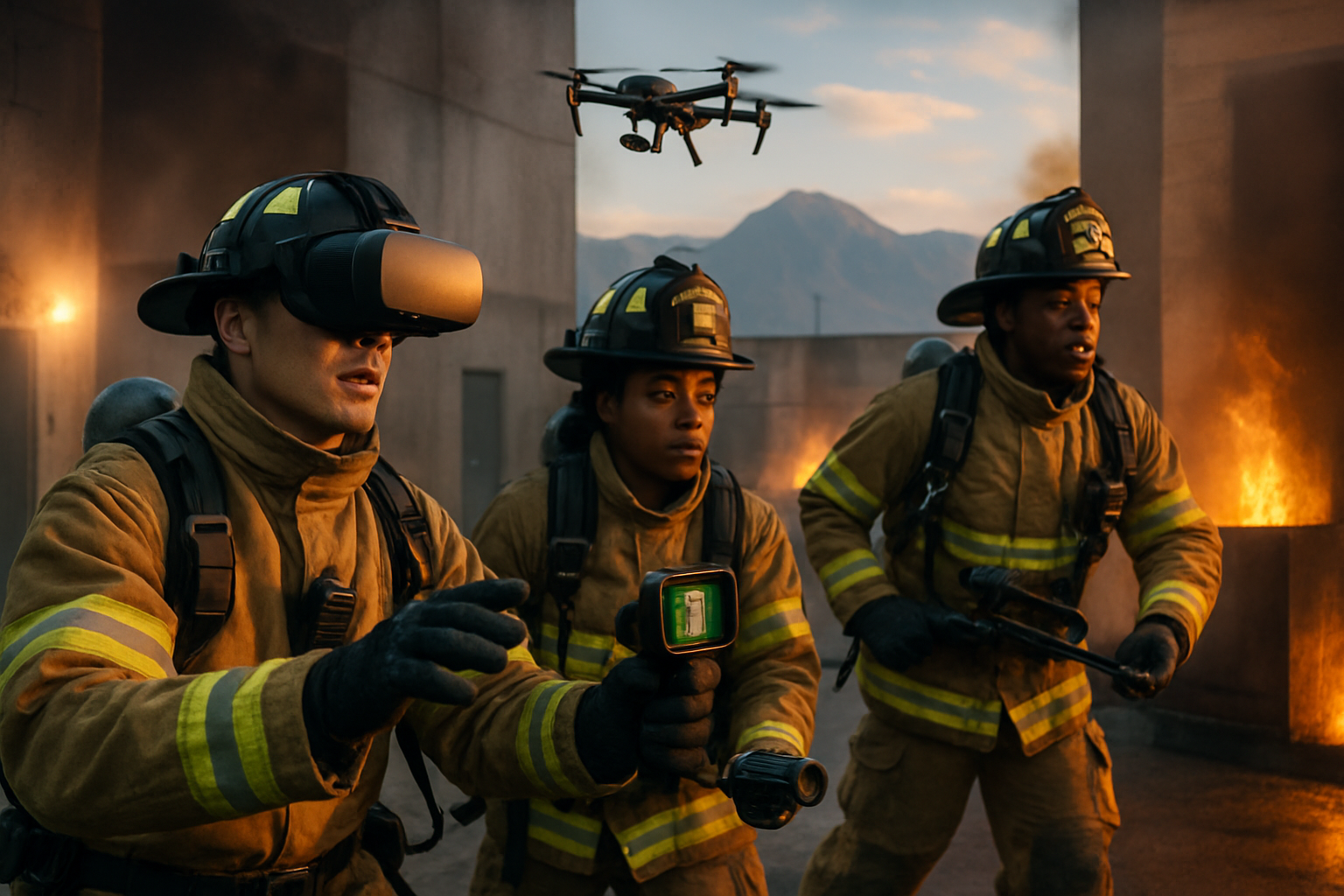
Utah's commitment to public safety is taking a significant leap forward as its Fire Science Programs increasingly adopt advanced training methodologies and eye innovative technological integrations. This strategic evolution aims to cultivate a new generation of firefighters equipped with unparalleled skills and endurance, ready to confront the multifaceted challenges of modern emergency response. The focus is on creating highly adaptable and resilient professionals capable of handling everything from urban structural fires to complex wildland incidents and hazardous materials scenarios.
The initiative underscores a proactive approach to firefighter preparedness, recognizing the evolving landscape of emergency services. By enhancing traditional hands-on training with cutting-edge tools and simulation techniques, Utah is setting a new standard for firefighter education. This progressive shift promises to bolster the safety of communities across the state, ensuring that future first responders are not only proficient but also at the forefront of emergency management innovation.
Forging Elite Responders: A Deep Dive into Utah's Training Evolution
Utah's Fire Science Programs, spearheaded by institutions like the Utah Fire and Rescue Academy (UFRA) at Utah Valley University (UVU), Davis Technical College, and Southwest Technical College, are at the vanguard of preparing future firefighters. These programs meticulously blend rigorous academic instruction with intensive practical experience, culminating in certifications such as Firefighter I & II, Hazardous Materials Operations, and Emergency Medical Technician (EMT). The emphasis is on a holistic skill set, ensuring graduates are versatile and capable across a broad spectrum of emergencies.
The core of current training involves extensive live-fire exercises at facilities like Logan City Fire Department's "Bates Motel" training tower, which provides realistic scenarios for fire ventilation, attack, and rescue operations. Hazardous materials training, technical rescue, and comprehensive wildland fire management are also integral components, often delivered through blended learning formats that combine online modules with hands-on sessions. UFRA's annual Winter Fire School further showcases this commitment, offering a wide array of classes and featuring vendor demonstrations of state-of-the-art equipment. While specific details on widespread, daily integration of cutting-edge technology into all curricula are still emerging, the trajectory is clear. Facilities like UVU's Mobile Command Training Center, acquired through federal grants, have been providing immersive, realistic training since 2009. This infrastructure allows for high-fidelity simulations that minimize risk while maximizing learning. The continuous exposure to advanced equipment at events and the adoption of blended learning approaches signify a steady march towards a more technologically sophisticated training environment for Utah's future firefighters.
Companies Poised to Benefit or Adapt in the Evolving Landscape
The push towards advanced training and technology integration in Utah's Fire Science Programs presents a unique landscape of opportunities and challenges for various public companies. Equipment manufacturers stand to gain significantly. Companies like MSA Safety Inc. (NYSE: MSA), a global leader in safety products, could see increased demand for advanced personal protective equipment (PPE), gas detection systems, and thermal imaging cameras. Similarly, FLIR Systems, Inc. (NASDAQ: FLIR), now part of Teledyne Technologies Inc. (NYSE: TDY), specializing in thermal cameras and imaging solutions, could experience a boost as fire departments seek to enhance situational awareness through advanced optics.
Beyond direct equipment, technology providers focusing on simulation and training software could also find new avenues. While specific publicly traded companies in this niche for fire services are fewer, the trend could benefit broader simulation technology firms if specialized modules are developed or acquired. Furthermore, companies involved in emergency vehicle manufacturing and outfitting, such as REV Group, Inc. (NYSE: REVG), which produces fire apparatus, might see demand for vehicles integrated with more advanced communication, navigation, and data systems designed to complement highly trained crews. Insurance companies, while not directly selling to fire departments, could indirectly benefit from better-trained firefighters leading to reduced property damage and fewer injuries, potentially impacting their claims ratios positively. Conversely, companies that fail to innovate or adapt their offerings to meet the evolving technological demands of modern fire services might find themselves losing market share to more forward-thinking competitors.
Broader Implications: A National Trend Towards Smarter Firefighting
Utah's proactive investment in advanced firefighter training is not an isolated event but rather a microcosm of a broader national and international trend towards "smarter firefighting." This evolution is driven by several factors: the increasing complexity of urban environments, the growing threat of wildland-urban interface (WUI) fires exacerbated by climate change, and the constant demand for improved safety and efficiency for first responders. The integration of technology, from advanced simulations to data analytics and robotics, is becoming a cornerstone of modern emergency services.
This shift has significant ripple effects. Competitors in other states and regions will likely feel pressure to upgrade their own training programs to match or exceed Utah's standards, fostering a healthy competition that ultimately benefits public safety. Partners, including federal agencies like FEMA and state emergency management offices, will find better-prepared local fire departments, leading to more effective coordinated responses during large-scale disasters. Regulatory bodies may also take cues from successful programs like Utah's, potentially leading to updated national standards for firefighter training and certification that incorporate more advanced technological proficiencies. Historically, major advancements in firefighting often follow significant incidents or technological breakthroughs. The current emphasis on simulation and data-driven training mirrors similar evolutions in aviation and military training, where high-stakes scenarios necessitate realistic, repeatable, and measurable training environments. This trend signifies a move away from purely reactive training to a more predictive and preventative approach, leveraging technology to anticipate and mitigate risks more effectively.
The Road Ahead: Innovation and Adaptation in Emergency Services
Looking ahead, the trajectory for Utah's Fire Science Programs and the broader emergency services sector points towards continuous innovation and strategic adaptation. In the short term, we can anticipate a more widespread integration of virtual reality (VR) and augmented reality (AR) into training curricula, offering highly immersive and customizable scenarios for everything from hazardous materials spills to complex rescue operations. This will allow firefighters to practice critical decision-making in a risk-free environment, honing their skills before facing real-world dangers. We may also see increased adoption of drone technology for reconnaissance, thermal imaging, and even initial attack in wildland fires, requiring future firefighters to be proficient in operating and interpreting data from these unmanned aerial systems.
Long-term possibilities include the development of AI-powered training modules that adapt to individual learning styles and performance, providing personalized feedback and targeted exercises. The concept of a "connected firefighter" will likely become a reality, with integrated sensor systems in PPE providing real-time biometric data and environmental readings to incident commanders, optimizing safety and resource deployment. These advancements will undoubtedly create new market opportunities for technology developers specializing in emergency services solutions, while also posing challenges for fire departments to secure funding and provide ongoing professional development for their personnel. Strategic pivots will be necessary for training academies to stay ahead of the curve, constantly updating their programs to reflect the latest technological capabilities and evolving threats. The ultimate outcome is a highly efficient, safer, and more effective fire service, capable of responding to any emergency with unparalleled expertise.
A New Era of Firefighting: Preparedness for the 21st Century
Utah's proactive investment in advanced training methods for its future firefighters marks a pivotal moment in emergency services preparedness. By embracing sophisticated simulations, potentially incorporating cutting-edge technology, and fostering a culture of continuous learning, the state is building a robust foundation for its first responders. The key takeaway is a clear commitment to enhancing both the skills and endurance of firefighters, ensuring they are not just reactive forces but highly capable and adaptable professionals ready for the complexities of the 21st century.
Moving forward, the market will likely see sustained growth in sectors providing advanced training tools, safety equipment, and emergency response technology. Investors should closely watch companies involved in simulation software, drone technology, and smart PPE, as these areas are poised for significant expansion. The lasting impact of Utah's initiative will likely be felt far beyond its borders, potentially influencing national standards and inspiring other regions to elevate their own firefighter training programs. This progressive approach is not merely about equipping firefighters with new gadgets; it's about fundamentally transforming how we prepare for and respond to emergencies, ultimately safeguarding communities and ensuring the well-being of those who bravely serve on the front lines.
This content is intended for informational purposes only and is not financial advice







